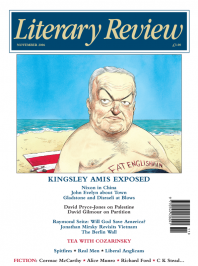Catherine Peters
House of Eliot
142 Strand: A Radical Address in Victorian London
By Rosemary Ashton
Chatto & Windus 386pp £20
It is important to be reminded from time to time of the strength of the radical, non-conformist element in Victorian society, so influential and so far from the ‘Victorian values’ of comfortable cliché. No one is better qualified to remind us than Rosemary Ashton, who has now added to her studies of George Eliot, G H Lewes and the Carlyles an intriguing account of the publisher John Chapman and his circle.
No 142 Strand was, for a few years in the mid nineteenth century, one of the most important addresses in literary London. The building itself has long since disappeared, but from 1847 to 1854, when John Chapman lived and worked there, it became a centre for radical ideas in political and scientific thought.
The house had been a tavern, then a hotel. It needed to be large, for it not only housed Chapman and his family but also his publishing business and, from 1852, the offices of the Westminster Review. In an attempt to bolster the finances of his other enterprises the upper

Sign Up to our newsletter
Receive free articles, highlights from the archive, news, details of prizes, and much more.@Lit_Review
Follow Literary Review on Twitter
Twitter Feed
It wasn’t until 1825 that Pepys’s diary became available for the first time. How it was eventually decrypted and published is a story of subterfuge and duplicity.
Kate Loveman tells the tale.
Kate Loveman - Publishing Pepys
Kate Loveman: Publishing Pepys
literaryreview.co.uk
Arthur Christopher Benson was a pillar of the Edwardian establishment. He was supremely well connected. As his newly published diaries reveal, he was also riotously indiscreet.
Piers Brendon compares Benson’s journals to others from the 20th century.
Piers Brendon - Land of Dopes & Tories
Piers Brendon: Land of Dopes & Tories - The Benson Diaries: Selections from the Diary of Arthur Christopher Benson by Eamon Duffy & Ronald Hyam (edd)
literaryreview.co.uk
Of the siblings Gwen and Augustus John, it is Augustus who has commanded most attention from collectors and connoisseurs.
Was he really the finer artist, asks Tanya Harrod, or is it time Gwen emerged from her brother’s shadow?
Tanya Harrod - Cut from the Same Canvas
Tanya Harrod: Cut from the Same Canvas - Artists, Siblings, Visionaries: The Lives and Loves of Gwen and Augustus John by Judith Mackrell
literaryreview.co.uk